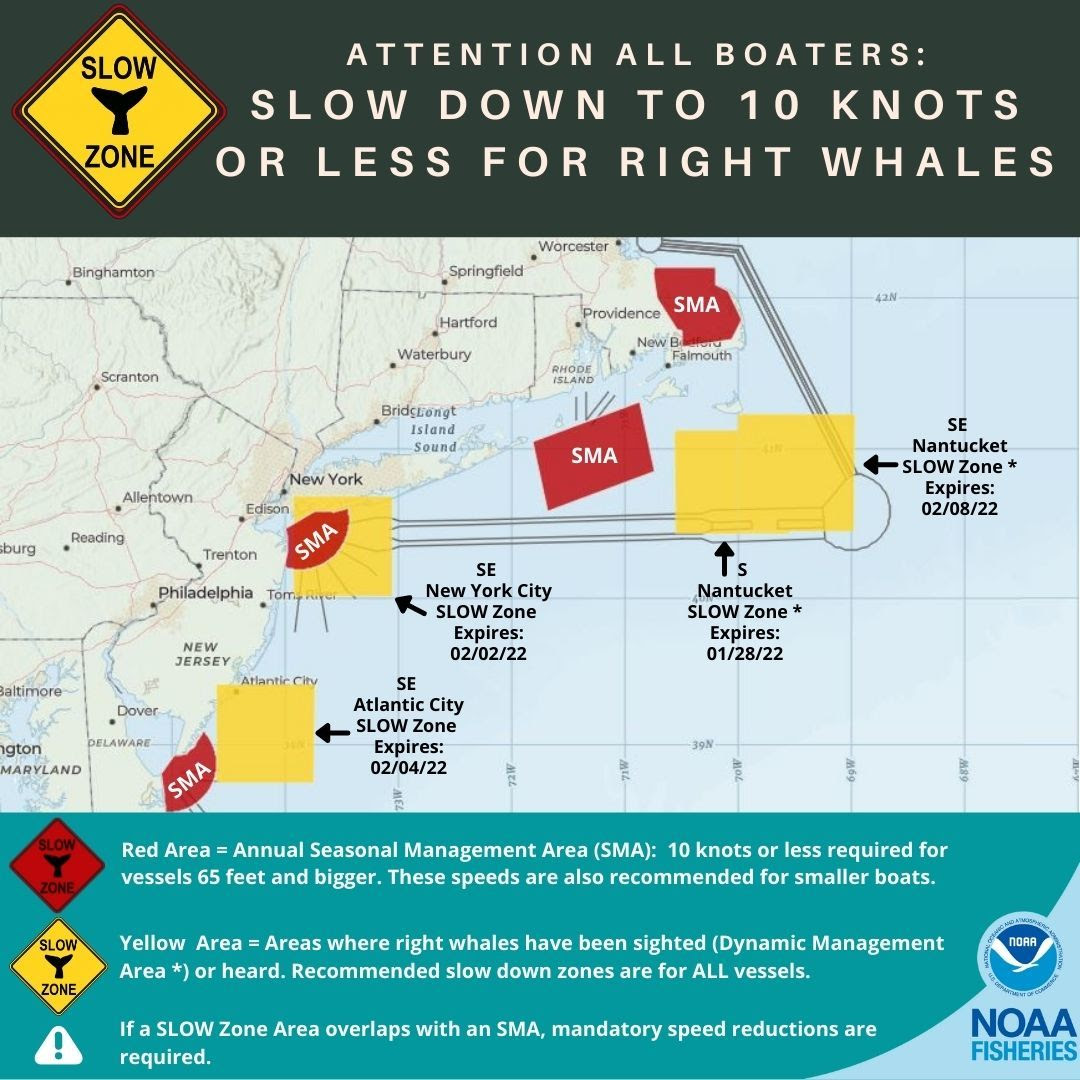New Right Whale Slow Zone Southeast of Nantucket, MA – Effective Through February 8
Posted
Last Updated
On January 24, 2022, the Center for Coastal Studies aerial survey team sighted right whales Southeast of Nantucket, MA. The right whale SLOW Zone (DMA/visual trigger) is in effect immediately and expires on February 8, 2022.
As a reminder, NOAA Fisheries also announced an acoustic SLOW Zone Southeast of Atlantic City, NJ. The Slow Zone expires February 4, 2022. There is also another SLOW Zone Southeast of New York City, NY. The Slow Zone expires February 2, 2022.
Lastly, there are two DMA SLOW Zones, one South of Nantucket, MA, and the other off Ocracoke, NC. The Slow Zones expire January 28, 2022.
VOLUNTARY Right whale “Slow Zone” AREAS
Mariners are requested to avoid or transit at 10 knots or less inside the following areas where persistent aggregations of right whales have been detected. Please visit www.nmfs.noaa.gov/pr/
Southeast of Nantucket, MA DMA SLOW Zone: Effective January 24-February 8, 2022
Waters bounded by:
NORTHERN BOUNDARY: 41°14′ N
SOUTHERN BOUNDARY: 40°27′ N
EASTERN BOUNDARY: 68°58′ W
WESTERN BOUNDARY: 70°00′ W
Southeast of Atlantic City, NJ Acoustic SLOW Zone: Effective January 20-February 4, 2022
Waters bounded by:
NORTHERN BOUNDARY: 39°25′ N
SOUTHERN BOUNDARY: 38°44′ N
EASTERN BOUNDARY: 73°44′ W
WESTERN BOUNDARY: 74°36′ W
Southeast of New York City, NY Acoustic SLOW Zone: Effective January 18-February 2, 2022
Waters bounded by:
NORTHERN BOUNDARY: 40°41′ N
SOUTHERN BOUNDARY: 40°01′ N
EASTERN BOUNDARY: 73°03′ W
WESTERN BOUNDARY: 73°55′ W
South of Nantucket, MA DMA SLOW Zone: Effective January 13-28, 2022
Waters bounded by:
NORTHERN BOUNDARY: 41°07′ N
SOUTHERN BOUNDARY: 40°26′ N
EASTERN BOUNDARY: 69°32′ W
WESTERN BOUNDARY: 70°34′ W
Ocracoke, NC DMA SLOW Zone: Effective January 13-28, 2022
Waters bounded by:
NORTHERN BOUNDARY: 35°14′ N
SOUTHERN BOUNDARY: 34°34′ N
EASTERN BOUNDARY: 75°24′ W
WESTERN BOUNDARY: 76°12′ W

Give Right Whales Room
North Atlantic right whales are on the move along the Atlantic coast of the U.S. If seen, remember that approaching a right whale closer than 500 yards is a violation of federal and state law.
Right Whales in Trouble
North Atlantic right whales are protected under the U.S. Endangered Species Act and the Marine Mammal Protection Act. Scientists estimate there are fewer than 350 individuals remaining, making them one of the rarest marine mammals in the world.
In August 2017, NOAA Fisheries declared the increase in right whale mortalities an “Unusual Mortality Event,” which helps the agency direct additional scientific and financial resources to investigating, understanding, and reducing the mortalities in partnership with the Marine Mammal Stranding Network, Canada’s Department of Fisheries and Oceans, and outside experts from the scientific research community.
More Information
Details and graphics of all of all vessel strike management zones currently in effect.
Download the Whale Alert app for iPad and iPhone for real time updates on Slow Zones, SMAs, and other right whale sightings.
Recent right whale sightings and real-time acoustic detections along the eastern seaboard.
Find out more about our right whale conservation efforts and the researchers behind those efforts.

